Convex uniform honeycomb

In geometry, a convex uniform honeycomb is a uniform tessellation which fills three-dimensional Euclidean space with non-overlapping convex uniform polyhedral cells.
Twenty-eight such honeycombs exist:
- the familiar cubic honeycomb and 7 truncations thereof;
- the alternated cubic honeycomb and 4 truncations thereof;
- 10 prismatic forms based on the uniform plane tilings (11 if including the cubic honeycomb);
- 5 modifications of some of the above by elongation and/or gyration.
They can be considered the three-dimensional analogue to the uniform tilings of the plane.
The Voronoi diagram of any lattice forms a convex uniform honeycomb in which the cells are zonohedra.
History
- 1900: Thorold Gosset enumerated the list of semiregular convex polytopes with regular cells (Platonic solids) in his publication On the Regular and Semi-Regular Figures in Space of n Dimensions, including one regular cubic honeycomb, and two semiregular forms with tetrahedra and octahedra.
- 1905: Alfredo Andreini enumerated 25 of these tessellations.
- 1991: Norman Johnson's manuscript Uniform Polytopes identified the complete list of 28.
- 1994: Branko Grünbaum, in his paper Uniform tilings of 3-space, also independently enumerated all 28, after discovering errors in Andreini's publication. He found the 1905 paper, which listed 25, had 1 wrong, and 4 being missing. Grünbaum states in this paper that Norman Johnson deserves priority for achieving the same enumeration in 1991. He also mentions that I. Alexeyev of Russia had contacted him regarding a putative enumeration of these forms, but that Grünbaum was unable to verify this at the time.
- 2006: George Olshevsky, in his manuscript Uniform Panoploid Tetracombs, along with repeating the derived list of 11 convex uniform tilings, and 28 convex uniform honeycombs, expands a further derived list of 143 convex uniform tetracombs (Honeycombs of uniform 4-polytopes in 4-space).
Only 14 of the convex uniform polyhedra appear in these patterns:
- three of the five Platonic solids,
- six of the thirteen Archimedean solids, and
- five of the infinite family of prisms.
Names
This set can be called the regular and semiregular honeycombs. It has been called the Archimedean honeycombs by analogy with the convex uniform (non-regular) polyhedra, commonly called Archimedean solids. Recently Conway has suggested naming the set as the Architectonic tessellations and the dual honeycombs as the Catoptric tessellations.
The individual honeycombs are listed with names given to them by Norman Johnson. (Some of the terms used below are defined in Uniform 4-polytope#Geometric derivations for 46 nonprismatic Wythoffian uniform 4-polytopes)
For cross-referencing, they are given with list indices from Andreini (1-22), Williams(1-2,9-19), Johnson (11-19, 21-25, 31-34, 41-49, 51-52, 61-65), and Grünbaum(1-28). Coxeter uses δ4 for a cubic honeycomb, hδ4 for an alternated cubic honeycomb, qδ4 for a quarter cubic honeycomb, with subscripts for other forms based on the ring patterns of the Coxeter diagram.
Compact Euclidean uniform tessellations (by their infinite Coxeter group families)
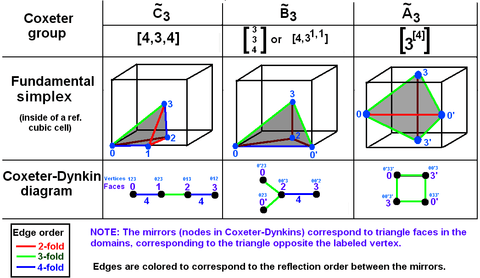

The fundamental infinite Coxeter groups for 3-space are:
- The , [4,3,4], cubic,






 (8 unique forms plus one alternation)
(8 unique forms plus one alternation) - The , [4,31,1], alternated cubic,




 (11 forms, 3 new)
(11 forms, 3 new) - The cyclic group, [(3,3,3,3)] or [3[4]],


 (5 forms, one new)
(5 forms, one new)
There is a correspondence between all three families. Removing one mirror from produces , and removing one mirror from produces . This allows multiple constructions of the same honeycombs. If cells are colored based on unique positions within each Wythoff construction, these different symmetries can be shown.
In addition there are 5 special honeycombs which don't have pure reflectional symmetry and are constructed from reflectional forms with elongation and gyration operations.
The total unique honeycombs above are 18.
The prismatic stacks from infinite Coxeter groups for 3-space are:
- The ×, [4,4,2,∞] prismatic group,








 (2 new forms)
(2 new forms) - The ×, [6,3,2,∞] prismatic group,








 (7 unique forms)
(7 unique forms) - The ×, [(3,3,3),2,∞] prismatic group,






 (No new forms)
(No new forms) - The ××, [∞,2,∞,2,∞] prismatic group,










 (These all become a cubic honeycomb)
(These all become a cubic honeycomb)
In addition there is one special elongated form of the triangular prismatic honeycomb.
The total unique prismatic honeycombs above (excluding the cubic counted previously) are 10.
Combining these counts, 18 and 10 gives us the total 28 uniform honeycombs.
The C~3, [4,3,4] group (cubic)
The regular cubic honeycomb, represented by Schläfli symbol {4,3,4}, offers seven unique derived uniform honeycombs via truncation operations. (One redundant form, the runcinated cubic honeycomb, is included for completeness though identical to the cubic honeycomb.) The reflectional symmetry is the affine Coxeter group [4,3,4]. There are four index 2 subgroups that generate alternations: [1+,4,3,4], [(4,3,4,2+)], [4,3+,4], and [4,3,4]+, with the first two generated repeated forms, and the last two are nonuniform.
| C3 honeycombs | |||||
|---|---|---|---|---|---|
| Space group |
Fibrifold | Extended symmetry |
Extended diagram |
Order | Honeycombs |
| Pm3m (221) |
4−:2 | [4,3,4] | ×1 | ||
| Fm3m (225) |
2−:2 | [1+,4,3,4] ↔ [4,31,1] |
↔ |
Half | |
| I43m (217) |
4o:2 | [[(4,3,4,2+)]] | Half × 2 | ||
| Fd3m (227) |
2+:2 | [[1+,4,3,4,1+]] ↔ [[3[4]]] |
↔ |
Quarter × 2 | |
| Im3m (229) |
8o:2 | [[4,3,4]] | ×2 | ||
| Reference Indices |
Honeycomb name Coxeter diagram and Schläfli symbol |
Cell counts/vertex and positions in cubic honeycomb |
|||||||
|---|---|---|---|---|---|---|---|---|---|
| (0) |
(1) |
(2) |
(3) |
Alt | Solids (Partial) |
Frames (Perspective) |
Vertex figure | ||
| J11,15 A1 W1 G22 δ4 |
cubic (chon) t0{4,3,4} {4,3,4} |
(8) (4.4.4) |
 |
 |
 octahedron | ||||
| J12,32 A15 W14 G7 O1 |
rectified cubic (rich) t1{4,3,4} r{4,3,4} |
(2) (3.3.3.3) |
(4) (3.4.3.4) |
 |
 |
 cuboid | |||
| J13 A14 W15 G8 t1δ4 O15 |
truncated cubic (tich) t0,1{4,3,4} t{4,3,4} |
(1) (3.3.3.3) |
(4) (3.8.8) |
 |
 |
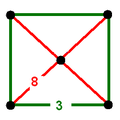 square pyramid | |||
| J14 A17 W12 G9 t0,2δ4 O14 |
cantellated cubic (srich) t0,2{4,3,4} rr{4,3,4} |
(1) (3.4.3.4) |
(2) (4.4.4) |
(2) (3.4.4.4) |
 |
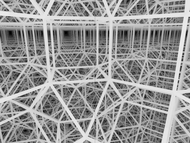 |
 oblique triangular prism | ||
| J17 A18 W13 G25 t0,1,2δ4 O17 |
cantitruncated cubic (grich) t0,1,2{4,3,4} tr{4,3,4} |
(1) (4.6.6) |
(1) (4.4.4) |
(2) (4.6.8) |
 |
 |
 irregular tetrahedron | ||
| J18 A19 W19 G20 t0,1,3δ4 O19 |
runcitruncated cubic (prich) t0,1,3{4,3,4} |
(1) (3.4.4.4) |
(1) (4.4.4) |
(2) (4.4.8) |
(1) (3.8.8) |
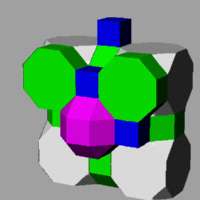 |
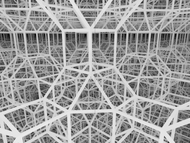 |
 oblique trapezoidal pyramid | |
| J21,31,51 A2 W9 G1 hδ4 O21 |
alternated cubic (octet) h{4,3,4} |
(8) (3.3.3) |
(6) (3.3.3.3) |
 |
 |
 cuboctahedron | |||
| J22,34 A21 W17 G10 h2δ4 O25 |
Cantic cubic (tatoh) |
(3.4.3.4) |
(4.6.6) |
(3.6.6) |
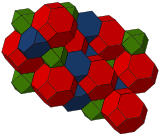 |
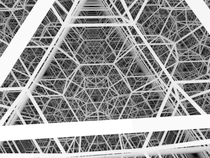 |
 rectangular pyramid | ||
| J23 A16 W11 G5 h3δ4 O26 |
Runcic cubic (ratoh) |
cube |
(3.4.4.4) |
(3.3.3) |
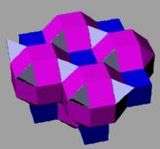 |
 |
 tapered triangular prism | ||
| J24 A20 W16 G21 h2,3δ4 O28 |
Runcicantic cubic (gratoh) |
(3.8.8) |
(4.6.8) |
(3.6.6) |
 |
 |
 Irregular tetrahedron | ||
| Nonuniformb | snub rectified cubic sr{4,3,4} |
(3.3.3.3.3) |
(3.3.3) |
(3.3.3.3.4) |
(3.3.3) |
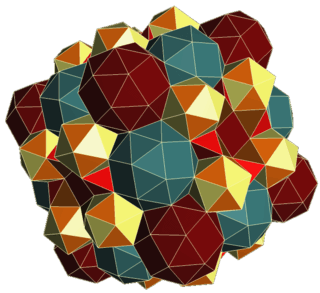 |
 Irr. tridiminished icosahedron | ||
| Nonuniform | Trirectified bisnub cubic 2s0{4,3,4} |
(3.3.3.3.3) |
(4.4.4) |
(4.4.4) |
(3.4.4.4) |
||||
| Nonuniform | Runcic cantitruncated cubic sr3{4,3,4} |
(3.4.4.4) |
(4.4.4) |
(4.4.4) |
(3.3.3.3.4) |
||||
| Reference Indices |
Honeycomb name Coxeter diagram and Schläfli symbol |
Cell counts/vertex and positions in cubic honeycomb |
|||||
|---|---|---|---|---|---|---|---|
| (0,3) |
(1,2) |
Alt | Solids (Partial) |
Frames (Perspective) |
Vertex figure | ||
| J11,15 A1 W1 G22 δ4 O1 |
runcinated cubic (same as regular cubic) (chon) t0,3{4,3,4} |
(2) (4.4.4) |
(6) (4.4.4) |
 |
 |
 octahedron | |
| J16 A3 W2 G28 t1,2δ4 O16 |
bitruncated cubic (batch) t1,2{4,3,4} 2t{4,3,4} |
(4) (4.6.6) |
 |
 |
 (disphenoid) | ||
| J19 A22 W18 G27 t0,1,2,3δ4 O20 |
omnitruncated cubic (otch) t0,1,2,3{4,3,4} |
(2) (4.6.8) |
(2) (4.4.8) |
 |
 |
 irregular tetrahedron | |
| J21,31,51 A2 W9 G1 hδ4 O27 |
Quarter cubic honeycomb ht0ht3{4,3,4} |
(2) (3.3.3) |
(6) (3.6.6) |
 |
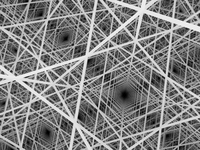 |
 elongated triangular antiprism | |
| J21,31,51 A2 W9 G1 hδ4 O21 |
Alternated runcinated cubic (same as alternated cubic) ht0,3{4,3,4} |
(4) (3.3.3) |
(4) (3.3.3) |
(6) (3.3.3.3) |
 |
 |
 cuboctahedron |
| Nonuniform | 2s0,3{(4,2,4,3)} |
||||||
| Nonuniforma | Alternated bitruncated cubic h2t{4,3,4} |
(3.3.3.3.3) |
(3.3.3) |
 |
 | ||
| Nonuniform | 2s0,3{4,3,4} |
||||||
| Nonuniformc | Alternated omnitruncated cubic ht0,1,2,3{4,3,4} |
(3.3.3.3.4) |
(3.3.3.4) |
(3.3.3) |
 | ||
B~4, [4,31,1] group
The , [4,3] group offers 11 derived forms via truncation operations, four being unique uniform honeycombs. There are 3 index 2 subgroups that generate alternations: [1+,4,31,1], [4,(31,1)+], and [4,31,1]+. The first generates repeated honeycomb, and the last two are nonuniform but included for completeness.
The honeycombs from this group are called alternated cubic because the first form can be seen as a cubic honeycomb with alternate vertices removed, reducing cubic cells to tetrahedra and creating octahedron cells in the gaps.
Nodes are indexed left to right as 0,1,0',3 with 0' being below and interchangeable with 0. The alternate cubic names given are based on this ordering.
| B3 honeycombs | |||||
|---|---|---|---|---|---|
| Space group |
Fibrifold | Extended symmetry |
Extended diagram |
Order | Honeycombs |
| Fm3m (225) |
2−:2 | [4,31,1] ↔ [4,3,4,1+] |
↔ |
×1 | |
| Fm3m (225) |
2−:2 | <[1+,4,31,1]> ↔ <[3[4]]> |
↔ |
×2 | |
| Pm3m (221) |
4−:2 | <[4,31,1]> | ×2 | ||
| Referenced indices |
Honeycomb name Coxeter diagrams |
Cells by location (and count around each vertex) |
Solids (Partial) |
Frames (Perspective) |
vertex figure | |||
|---|---|---|---|---|---|---|---|---|
| (0) |
(1) |
(0') |
(3) | |||||
| J21,31,51 A2 W9 G1 hδ4 O21 |
Alternated cubic (octet) |
(3.3.3.3) |
(3.3.3) |
 |
 |
 cuboctahedron | ||
| J22,34 A21 W17 G10 h2δ4 O25 |
Cantic cubic (tatoh) |
(3.4.3.4) |
(4.6.6) |
(3.6.6) |
 |
 |
 rectangular pyramid | |
| J23 A16 W11 G5 h3δ4 O26 |
Runcic cubic (ratoh) |
cube |
(3.4.4.4) |
(3.3.3) |
 |
 |
 tapered triangular prism | |
| J24 A20 W16 G21 h2,3δ4 O28 |
Runcicantic cubic (gratoh) |
(3.8.8) |
(4.6.8) |
(3.6.6) |
 |
 |
 Irregular tetrahedron | |
| Referenced indices |
Honeycomb name Coxeter diagrams |
Cells by location (and count around each vertex) |
Solids (Partial) |
Frames (Perspective) |
vertex figure | |||
|---|---|---|---|---|---|---|---|---|
| (0,0') |
(1) |
(3) |
Alt | |||||
| J11,15 A1 W1 G22 δ4 O1 |
Cubic (chon) |
(4.4.4) |
 |
 |
 octahedron | |||
| J12,32 A15 W14 G7 t1δ4 O15 |
Rectified cubic (rich) |
(3.4.3.4) |
(3.3.3.3) |
 |
 |
 cuboid | ||
| Rectified cubic (rich) |
(3.3.3.3) |
(3.4.3.4) |
 |
 cuboid | ||||
| J13 A14 W15 G8 t0,1δ4 O14 |
Truncated cubic (tich) |
(3.8.8) |
(3.3.3.3) |
 |
 |
 square pyramid | ||
| J14 A17 W12 G9 t0,2δ4 O17 |
Cantellated cubic (srich) |
(3.4.4.4) |
(4.4.4) |
(3.4.3.4) |
 |
 |
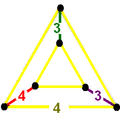 obilique triangular prism | |
| J16 A3 W2 G28 t0,2δ4 O16 |
Bitruncated cubic (batch) |
(4.6.6) |
(4.6.6) |
 |
 |
 isosceles tetrahedron | ||
| J17 A18 W13 G25 t0,1,2δ4 O18 |
Cantitruncated cubic (grich) |
(4.6.8) |
(4.4.4) |
(4.6.6) |
 |
 |
 irregular tetrahedron | |
| J21,31,51 A2 W9 G1 hδ4 O21 |
Alternated cubic (octet) |
(3.3.3) |
(3.3.3.3) |
 |
 |
 cuboctahedron | ||
| J22,34 A21 W17 G10 h2δ4 O25 |
Cantic cubic (tatoh) |
(3.6.6) |
(3.4.3.4) |
(4.6.6) |
 |
 |
 rectangular pyramid | |
| Nonuniforma | Alternated bitruncated cubic |
(3.3.3.3.3) |
(3.3.3.3.3) |
(3.3.3) |
 | |||
| Nonuniformb | Alternated cantitruncated cubic |
(3.3.3.3.4) |
(3.3.3) |
(3.3.3.3.3) |
(3.3.3) |
 |
 Irr. tridiminished icosahedron | |
A~3, [3[4])] group
There are 5 forms[1] constructed from the , [3[4]] Coxeter group, of which only the quarter cubic honeycomb is unique. There is one index 2 subgroup [3[4]]+ which generates the snub form, which is not uniform, but included for completeness.
| A3 honeycombs | ||||||
|---|---|---|---|---|---|---|
| Space group |
Fibrifold | Square symmetry |
Extended symmetry |
Extended diagram |
Extended group |
Honeycomb diagrams |
| F43m (216) |
1o:2 | a1 |
[3[4]] | (None) | ||
| Fm3m (225) |
2−:2 | d2 |
<[3[4]]> ↔ [4,31,1] |
↔ |
×21 ↔ |
|
| Fd3m (227) |
2+:2 | g2 |
[[3[4]]] or [2+[3[4]]] |
↔ |
×22 | |
| Pm3m (221) |
4−:2 | d4 |
<2[3[4]]> ↔ [4,3,4] |
↔ |
×41 ↔ |
|
| I3 (204) |
8−o | r8 |
[4[3[4]]]+ ↔ [[4,3<sup>+</sup>,4]] |
↔ |
½×8 ↔ ½×2 |
|
| Im3m (229) |
8o:2 | [4[3[4]]] ↔ 4,3,4 |
×8 ↔ ×2 |
|||
| Referenced indices |
Honeycomb name Coxeter diagrams |
Cells by location (and count around each vertex) |
Solids (Partial) |
Frames (Perspective) |
vertex figure | |
|---|---|---|---|---|---|---|
| (0,1) |
(2,3) | |||||
| J25,33 A13 W10 G6 qδ4 O27 |
quarter cubic (batatoh) q{4,3,4} |
(3.3.3) |
(3.6.6) |
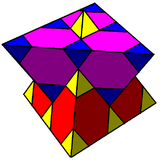 |
 |
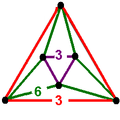 triangular antiprism |
| Referenced indices |
Honeycomb name Coxeter diagrams |
Cells by location (and count around each vertex) |
Solids (Partial) |
Frames (Perspective) |
vertex figure | ||
|---|---|---|---|---|---|---|---|
| 0 | (1,3) | 2 | |||||
| J21,31,51 A2 W9 G1 hδ4 O21 |
alternated cubic (octet) h{4,3,4} |
(3.3.3) |
(3.3.3.3) |
 |
 |
 cuboctahedron | |
| J22,34 A21 W17 G10 h2δ4 O25 |
cantic cubic (tatoh) h2{4,3,4} |
(3.6.6) |
(3.4.3.4) |
(4.6.6) |
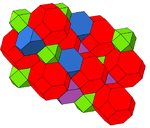 |
 |
 Rectangular pyramid |
| Referenced indices |
Honeycomb name Coxeter diagrams |
Cells by location (and count around each vertex) |
Solids (Partial) |
Frames (Perspective) |
vertex figure | |
|---|---|---|---|---|---|---|
| (0,2) |
(1,3) | |||||
| J12,32 A15 W14 G7 t1δ4 O1 |
rectified cubic (rich) r{4,3,4} |
(3.4.3.4) |
(3.3.3.3) |
 |
 |
 cuboid |
| Referenced indices |
Honeycomb name Coxeter diagrams |
Cells by location (and count around each vertex) |
Solids (Partial) |
Frames (Perspective) |
vertex figure | |
|---|---|---|---|---|---|---|
| (0,1,2,3) |
Alt | |||||
| J16 A3 W2 G28 t1,2δ4 O16 |
bitruncated cubic (batch) 2t{4,3,4} |
(4.6.6) |
 |
 |
 isosceles tetrahedron | |
| Nonuniforma | Alternated cantitruncated cubic h2t{4,3,4} |
(3.3.3.3.3) |
(3.3.3) |
 | ||
Nonwythoffian forms (gyrated and elongated)
Three more uniform honeycombs are generated by breaking one or another of the above honeycombs where its faces form a continuous plane, then rotating alternate layers by 60 or 90 degrees (gyration) and/or inserting a layer of prisms (elongation).
The elongated and gyroelongated alternated cubic tilings have the same vertex figure, but are not alike. In the elongated form, each prism meets a tetrahedron at one triangular end and an octahedron at the other. In the gyroelongated form, prisms that meet tetrahedra at both ends alternate with prisms that meet octahedra at both ends.
The gyroelongated triangular prismatic tiling has the same vertex figure as one of the plain prismatic tilings; the two may be derived from the gyrated and plain triangular prismatic tilings, respectively, by inserting layers of cubes.
| Referenced indices |
symbol | Honeycomb name | cell types (# at each vertex) | Solids (Partial) |
Frames (Perspective) |
vertex figure |
|---|---|---|---|---|---|---|
| J52 A2' G2 O22 |
h{4,3,4}:g | gyrated alternated cubic (gytoh) | tetrahedron (8) octahedron (6) |
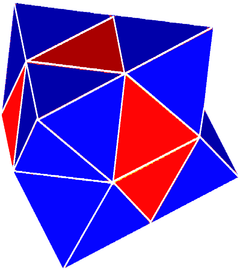 |
 |
 triangular orthobicupola |
| J61 A? G3 O24 |
h{4,3,4}:ge | gyroelongated alternated cubic (gyetoh) | triangular prism (6) tetrahedron (4) octahedron (3) |
 |
 |
 |
| J62 A? G4 O23 |
h{4,3,4}:e | elongated alternated cubic (etoh) | triangular prism (6) tetrahedron (4) octahedron (3) |
 |
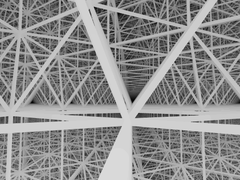 | |
| J63 A? G12 O12 |
{3,6}:g × {∞} | gyrated triangular prismatic (gytoph) | triangular prism (12) | 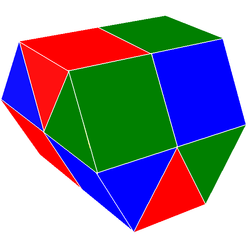 |
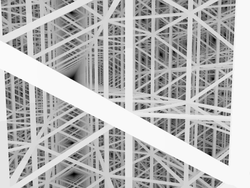 |
 |
| J64 A? G15 O13 |
{3,6}:ge × {∞} | gyroelongated triangular prismatic (gyetaph) | triangular prism (6) cube (4) |
 |
 |
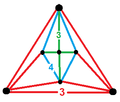 |
Prismatic stacks
Eleven prismatic tilings are obtained by stacking the eleven uniform plane tilings, shown below, in parallel layers. (One of these honeycombs is the cubic, shown above.) The vertex figure of each is an irregular bipyramid whose faces are isosceles triangles.
The C~2×I~1(∞), [4,4,2,∞], prismatic group
There are only 3 unique honeycombs from the square tiling, but all 6 tiling truncations are listed below for completeness, and tiling images are shown by colors corresponding to each form.
| Indices | Coxeter-Dynkin and Schläfli symbols |
Honeycomb name | Plane tiling |
Solids (Partial) |
Tiling |
|---|---|---|---|---|---|
| J11,15 A1 G22 |
{4,4}×{∞} |
Cubic (Square prismatic) (chon) |
(4.4.4.4) |  |
 |
r{4,4}×{∞} |
 | ||||
rr{4,4}×{∞} |
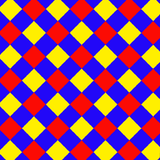 | ||||
| J45 A6 G24 |
t{4,4}×{∞} |
Truncated/Bitruncated square prismatic (tassiph) | (4.8.8) |  |
|
tr{4,4}×{∞} |
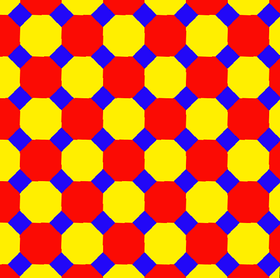 | ||||
| J44 A11 G14 |
sr{4,4}×{∞} |
Snub square prismatic (sassiph) | (3.3.4.3.4) |  |
 |
| Nonuniform | ht0,1,2,3{4,4,2,∞} |
The G~2xI~1(∞), [6,3,2,∞] prismatic group
| Indices | Coxeter-Dynkin and Schläfli symbols |
Honeycomb name | Plane tiling |
Solids (Partial) |
Tiling |
|---|---|---|---|---|---|
| J41 A4 G11 |
{3,6} × {∞} |
Triangular prismatic (tiph) | (36) | 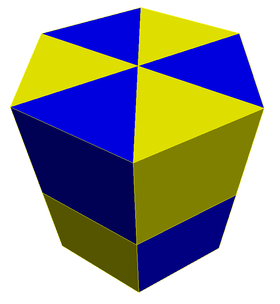 |
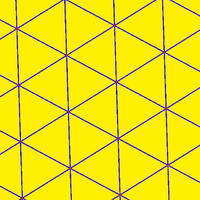 |
| J42 A5 G26 |
{6,3} × {∞} |
Hexagonal prismatic (hiph) | (63) |  |
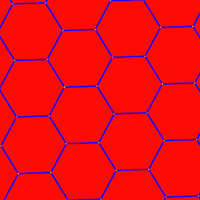 |
t{3,6} × {∞} |
 |
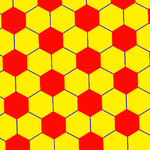 | |||
| J43 A8 G18 |
r{6,3} × {∞} |
Trihexagonal prismatic (thiph) | (3.6.3.6) |  |
 |
| J46 A7 G19 |
t{6,3} × {∞} |
Truncated hexagonal prismatic (thaph) | (3.12.12) | 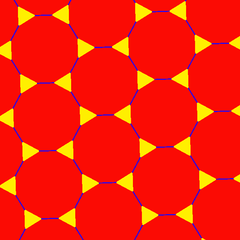 | |
| J47 A9 G16 |
rr{6,3} × {∞} |
Rhombi-trihexagonal prismatic (rothaph) | (3.4.6.4) |  |
 |
| J48 A12 G17 |
sr{6,3} × {∞} |
Snub hexagonal prismatic (snathaph) | (3.3.3.3.6) |  | |
| J49 A10 G23 |
tr{6,3} × {∞} |
truncated trihexagonal prismatic (otathaph) | (4.6.12) | 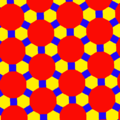 | |
| J65 A11' G13 |
{3,6}:e × {∞} |
elongated triangular prismatic (etoph) | (3.3.3.4.4) |  |
 |
| J52 A2' G2 |
h3t{3,6,2,∞} |
gyrated tetrahedral-octahedral (gytoh) | (36) |  |
 |
s2r{3,6,2,∞} | |||||
| Nonuniform | ht0,1,2,3{3,6,2,∞} |
Enumeration of Wythoff forms
All nonprismatic Wythoff constructions by Coxeter groups are given below, along with their alternations. Uniform solutions are indexed with Branko Grünbaum's listing. Green backgrounds are shown on repeated honeycombs, with the relations are expressed in the extended symmetry diagrams.
| Coxeter group | Extended symmetry |
Honeycombs | Chiral extended symmetry |
Alternation honeycombs | ||
|---|---|---|---|---|---|---|
| [4,3,4] | [4,3,4] | 6 | |
[1+,4,3+,4,1+] | (2) | |
| [2+[4,3,4]] | (1) | [2+[(4,3+,4,2+)]] | (1) | | ||
| [2+[4,3,4]] | 1 | [2+[(4,3+,4,2+)]] | (1) | |||
| [2+[4,3,4]] | 2 | [2+[4,3,4]]+ | (1) | |||
| [4,31,1] | [4,31,1] | 4 | |
|||
| [1[4,31,1]]=[4,3,4] | (7) | [1[1+,4,31,1]]+ | (2) | | ||
| [1[4,31,1]]+ =[4,3,4]+ | (1) | |||||
| [3[4]] | [3[4]] | (none) | ||||
| [2+[3[4]]] | 1 | |
||||
| [1[3[4]]]=[4,31,1] | (2) | |
||||
| [2[3[4]]]=[4,3,4] | (1) | |
||||
| [(2+,4)[3[4]]]=[2+[4,3,4]] | (1) | |
[(2+,4)[3[4]]]+ = [2+[4,3,4]]+ |
(1) | | |
Examples
All 28 of these tessellations are found in crystal arrangements.
The alternated cubic honeycomb is of special importance since its vertices form a cubic close-packing of spheres. The space-filling truss of packed octahedra and tetrahedra was apparently first discovered by Alexander Graham Bell and independently re-discovered by Buckminster Fuller (who called it the octet truss and patented it in the 1940s). . Octet trusses are now among the most common types of truss used in construction.
Frieze forms
If cells are allowed to be uniform tilings, more uniform honeycombs can be defined:
Families:
- x: [4,4,2]






 Cubic slab honeycombs (3 forms)
Cubic slab honeycombs (3 forms) - x: [6,3,2]






 Tri-hexagonal slab honeycombs (8 forms)
Tri-hexagonal slab honeycombs (8 forms) - x: [(3,3,3),2]




 Triangular slab honeycombs (No new forms)
Triangular slab honeycombs (No new forms) - xx: [∞,2,2]






 =
= 





 Cubic column honeycombs (1 form)
Cubic column honeycombs (1 form) - x: [p,2,∞]






 Polygonal column honeycombs
Polygonal column honeycombs - xx: [∞,2,∞,2] = [4,4,2] -








 =
= 





 (Same as cubic slab honeycomb family)
(Same as cubic slab honeycomb family)
| Cubic slab honeycomb |
Alternated hexagonal slab honeycomb |
Trihexagonal slab honeycomb |
|---|---|---|
 |
 |
 |
 (4) 43: cube (1) 44: square tiling |
 (4) 33: tetrahedron (3) 34: octahedron (1) 36: hexagonal tiling |
 (2) 3.4.4: triangular prism (2) 4.4.6: hexagonal prism (1) (3.6)2: trihexagonal tiling |
Scaliform honeycomb
A scaliform honeycomb is vertex-transitive, like a uniform honeycomb, with regular polygon faces while cells and higher elements are only required to be orbiforms, equilateral, with their vertices lying on hyperspheres. For 3D honeycombs, this allows a subset of Johnson solids along with the uniform polyhedra. Some scaliforms can be generated by an alternation process, leaving, for example, pyramid and cupola gaps.[2]
| Frieze slabs | Prismatic stacks | ||
|---|---|---|---|
| s3{2,6,3}, |
s3{2,4,4}, |
s{2,4,4}, |
3s4{4,4,2,∞}, |
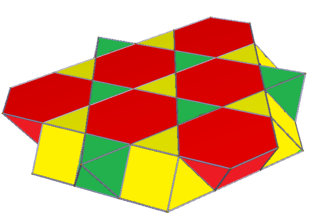 |
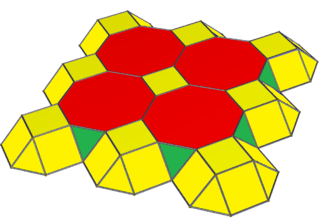 |
 |
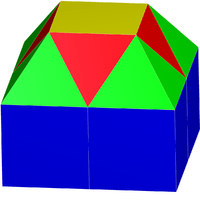 |
| |
|
|
|
 (1) 3.4.3.4: triangular cupola (2) 3.4.6: triangular cupola (1) 3.3.3.3: octahedron (1) 3.6.3.6: trihexagonal tiling |
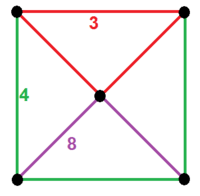 (1) 3.4.4.4: square cupola (2) 3.4.8: square cupola (1) 3.3.3: tetrahedron (1) 4.8.8: truncated square tiling |
 (1) 3.3.3.3: square pyramid (4) 3.3.4: square pyramid (4) 3.3.3: tetrahedron (1) 4.4.4.4: square tiling |
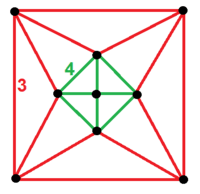 (1) 3.3.3.3: square pyramid (4) 3.3.4: square pyramid (4) 3.3.3: tetrahedron (4) 4.4.4: cube |
Hyperbolic forms

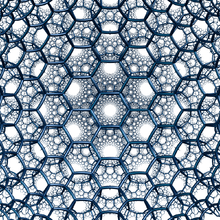
There are 9 Coxeter group families of compact uniform honeycombs in hyperbolic 3-space, generated as Wythoff constructions, and represented by ring permutations of the Coxeter-Dynkin diagrams for each family.
From these 9 families, there are a total of 76 unique honeycombs generated:
- [3,5,3] :






 - 9 forms
- 9 forms - [5,3,4] :






 - 15 forms
- 15 forms - [5,3,5] :






 - 9 forms
- 9 forms - [5,31,1] :




 - 11 forms (7 overlap with [5,3,4] family, 4 are unique)
- 11 forms (7 overlap with [5,3,4] family, 4 are unique) - [(4,3,3,3)] :



 - 9 forms
- 9 forms - [(4,3,4,3)] :




 - 6 forms
- 6 forms - [(5,3,3,3)] :



 - 9 forms
- 9 forms - [(5,3,4,3)] :




 - 9 forms
- 9 forms - [(5,3,5,3)] :




 - 6 forms
- 6 forms
The full list of hyperbolic uniform honeycombs has not been proven and an unknown number of non-Wythoffian forms exist. One known example is in the {3,5,3} family.
Paracompact hyperbolic forms
There are also 23 paracompact Coxeter groups of rank 4. These families can produce uniform honeycombs with unbounded facets or vertex figure, including ideal vertices at infinity:
| Type | Coxeter groups | Unique honeycomb count |
|---|---|---|
| Linear graphs | |
4×15+6+8+8 = 82 |
| Tridental graphs | |
4+4+0 = 8 |
| Cyclic graphs | |
4×9+5+1+4+1+0 = 47 |
| Loop-n-tail graphs | |
4+4+4+2 = 14 |
References
- ↑ , A000029 6-1 cases, skipping one with zero marks
- ↑ http://bendwavy.org/klitzing/explain/polytope-tree.htm#scaliform
- John H. Conway, Heidi Burgiel, Chaim Goodman-Strauss, (2008) The Symmetries of Things, ISBN 978-1-56881-220-5 (Chapter 21, Naming the Archimedean and Catalan polyhedra and tilings, Architectonic and Catoptric tessellations, p 292-298, includes all the nonprismatic forms)
- George Olshevsky, (2006, Uniform Panoploid Tetracombs, Manuscript (Complete list of 11 convex uniform tilings, 28 convex uniform honeycombs, and 143 convex uniform tetracombs)
- Branko Grünbaum, (1994) Uniform tilings of 3-space. Geombinatorics 4, 49 - 56.
- Norman Johnson (1991) Uniform Polytopes, Manuscript
- Williams, Robert (1979). The Geometrical Foundation of Natural Structure: A Source Book of Design. Dover Publications, Inc. ISBN 0-486-23729-X. (Chapter 5: Polyhedra packing and space filling)
- Critchlow, Keith (1970). Order in Space: A design source book. Viking Press. ISBN 0-500-34033-1.
- Kaleidoscopes: Selected Writings of H.S.M. Coxeter, edited by F. Arthur Sherk, Peter McMullen, Anthony C. Thompson, Asia Ivic Weiss, Wiley-Interscience Publication, 1995, ISBN 978-0-471-01003-6
- (Paper 22) H.S.M. Coxeter, Regular and Semi Regular Polytopes I, [Math. Zeit. 46 (1940) 380-407, MR 2,10] (1.9 Uniform space-fillings)
- A. Andreini, (1905) Sulle reti di poliedri regolari e semiregolari e sulle corrispondenti reti correlative (On the regular and semiregular nets of polyhedra and on the corresponding correlative nets), Mem. Società Italiana della Scienze, Ser.3, 14 75–129. PDF
- D. M. Y. Sommerville, (1930) An Introduction to the Geometry of n Dimensions. New York, E. P. Dutton, . 196 pp. (Dover Publications edition, 1958) Chapter X: The Regular Polytopes
- Anthony Pugh (1976). Polyhedra: A visual approach. California: University of California Press Berkeley. ISBN 0-520-03056-7. Chapter 5. Joining polyhedra
- Crystallography of Quasicrystals: Concepts, Methods and Structures by Walter Steurer, Sofia Deloudi (2009), p.54-55. 12 packings of 2 or more uniform polyhedra with cubic symmetry
External links
| Wikimedia Commons has media related to Uniform tilings of Euclidean 3-space. |
- Uniform Honeycombs in 3-Space VRML models
- Elementary Honeycombs Vertex transitive space filling honeycombs with non-uniform cells.
- Uniform partitions of 3-space, their relatives and embedding, 1999
- The Uniform Polyhedra
- Virtual Reality Polyhedra The Encyclopedia of Polyhedra
- octet truss animation
- Review: A. F. Wells, Three-dimensional nets and polyhedra, H. S. M. Coxeter (Source: Bull. Amer. Math. Soc. Volume 84, Number 3 (1978), 466-470.)
- Klitzing, Richard. "3D Euclidean tesselations".
| Fundamental convex regular and uniform honeycombs in dimensions 3–10 (or 2-9) | |||||
|---|---|---|---|---|---|
| Family | / / | ||||
| Uniform tiling | {3[3]} | δ3 | hδ3 | qδ3 | Hexagonal |
| Uniform convex honeycomb | {3[4]} | δ4 | hδ4 | qδ4 | |
| Uniform 5-honeycomb | {3[5]} | δ5 | hδ5 | qδ5 | 24-cell honeycomb |
| Uniform 6-honeycomb | {3[6]} | δ6 | hδ6 | qδ6 | |
| Uniform 7-honeycomb | {3[7]} | δ7 | hδ7 | qδ7 | 222 |
| Uniform 8-honeycomb | {3[8]} | δ8 | hδ8 | qδ8 | 133 • 331 |
| Uniform 9-honeycomb | {3[9]} | δ9 | hδ9 | qδ9 | 152 • 251 • 521 |
| Uniform 10-honeycomb | {3[10]} | δ10 | hδ10 | qδ10 | |
| Uniform n-honeycomb | {3[n]} | δn | hδn | qδn | 1k2 • 2k1 • k21 |